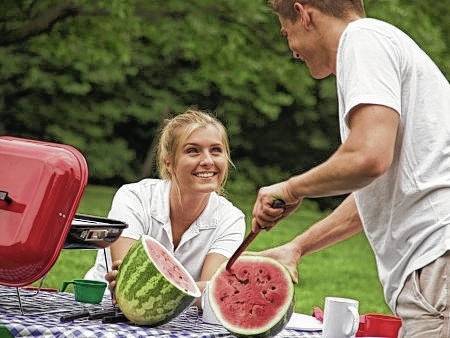
Question: I’m planning to pack a picnic for our 4th of July celebration in the park. To save time, can I partially cook the ribs at home and finish cooking them later on the grill during the picnic?
Answer: While it’s understandable that you’d want to save time by partially cooking your meats before heading to the park, doing so could result in a case of foodborne illness. This is because partial cooking does not destroy bacteria that can cause illness. The added heat during partial cooking can allow these bacteria to grow to unsafe levels. A safer option is to fully cook the meats to a safe internal temperature on the grill at the picnic.
You should also use a meat thermometer to judge the doneness of the meat — don’t rely on the color of the food as an indicator of whether it is done. Beef and pork should be cooked to an internal temperature of 160 degrees, while chicken should be cooked to an internal temperature of 165 degrees.
With July being designated as National Picnic Month, now is a good time to familiarize yourself with some other food safety tips to ensure you, your family and friends can enjoy months of summer picnics and barbecues without the potential for foodborne illnesses such as Salmonella or Listeria.
For example, did you know that it is better to store your cooler in the air-conditioned car as you drive to the park or beach for your picnic rather than placing it in a hot trunk? Or if you plan to buy takeout foods such as fried chicken for your picnic, you need to eat the food within two hours of purchase to avoid developing foodborne illness?
Or if you plan to make potato, egg or pasta salad, you should cool the potatoes, eggs or pasta and other ingredients to refrigerator temperature (below 40 degrees) before assembling? This prevents the salad from going into the temperature “danger zone” —between 40 and 140 degrees — where bacteria multiply rapidly during prep or storage.
The U.S. Food and Drug Administration and the U.S. Department of Agriculture Food Safety and Inspection Service offer these other tips for safe, healthy picnics and barbecues:
Always use an insulated cooler with a cold source, such as ice, frozen gel packs or frozen foods.
Pack cold food first, right from the refrigerator. Keep food cold until ready to cook.
Cold salads, such as potato, chicken or pasta, should be kept cold until serving.
Plan to keep hot foods hot with a thermos or insulated dish.
Pack uncooked meat, poultry and seafood separately from all ready-to-eat foods, such as beverages, fruits and side dishes. A separate cooler for uncooked meats is an even better idea!
Avoid produce that’s bruised or damaged.
When choosing fresh-cut produce, such as half a melon or bagged mixed greens, pick only items that are refrigerated or surrounded by ice.
Store perishable produce, including berries, lettuce, herbs and mushrooms, as well as all cut or peeled produce, at 40 degrees or below.
Use a fresh, clean plate for serving cooked food. Don’t let raw meat juices touch other food.
Place leftovers promptly in the cooler and store it in the shade to stay cool. Discard any perishable food left out for more than two hours.
Remember, although most perishable foods are safe to be left out for two hours, in hot weather, especially in temperatures above 90 degrees, food should not sit out for more than an hour. And while this may seem intuitive, it’s important that you wash your hands, your work area and all utensils before, during and after preparing food.


